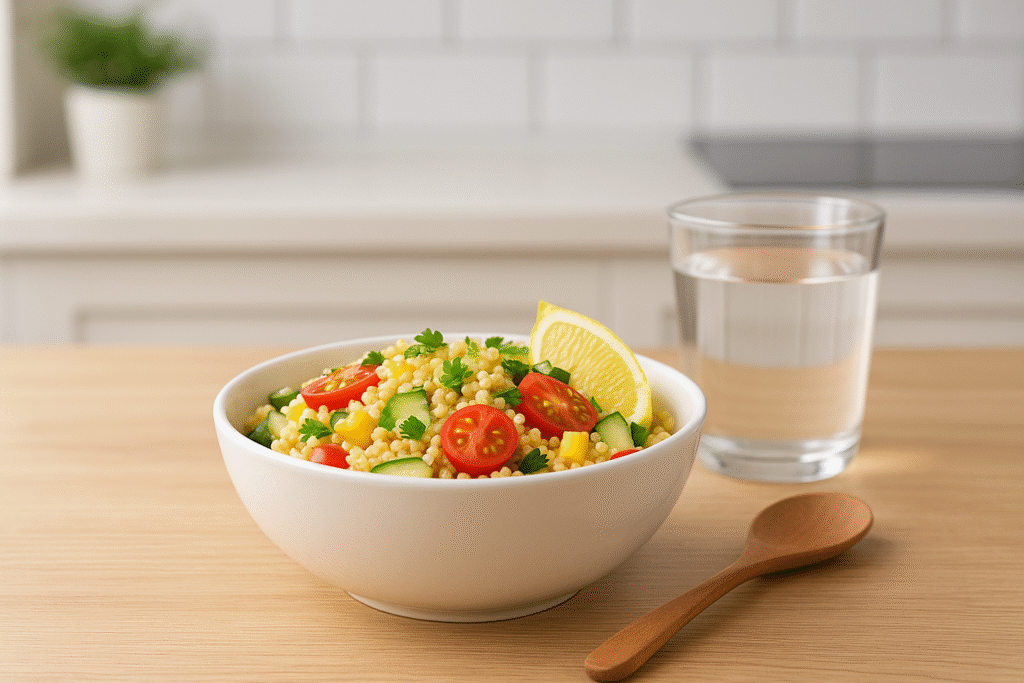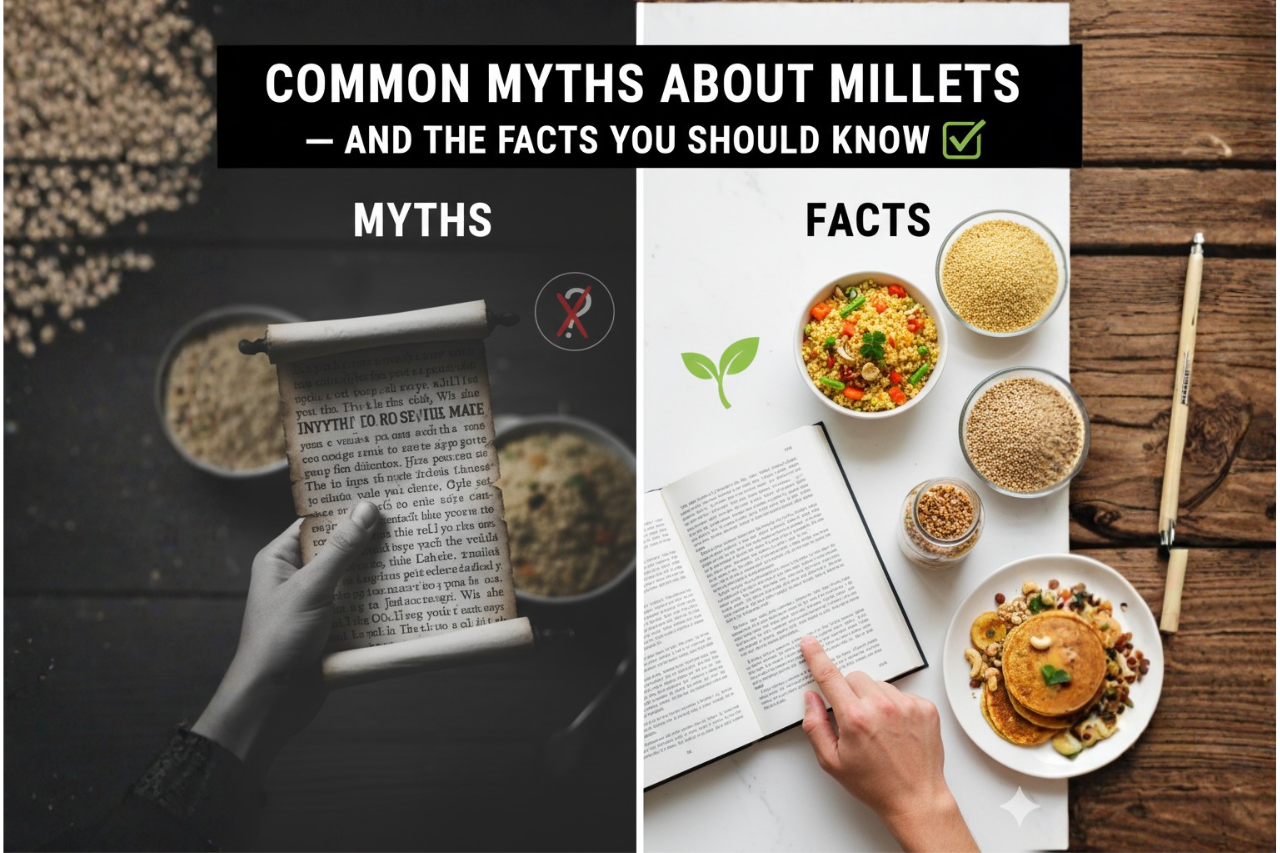When you scan the internet for Common Myths About Millets, there’s a bunch of chatter out there—from “millets are just for poor folks” to “they taste bland and are hard to digest”. Let’s cut through that noise. I’ll walk you through what’s real, what’s not, and help you spot what to believe (and what to ignore) when it comes to these tiny grains. You’ll see why millets, contrary to some beliefs, are pretty solid. I’ll use plain language, throw in some colloquial phrases, and yes—maybe a tiny typo or two here and there (just to keep it human).
Why Talk About Millets?
Before we jump into the myths, let’s get a quick bird’s-eye view of what millets are and why they’re showing up in so many conversations lately.
- Definition & variety: Millets are a group of small-seeded grasses grown as cereal crops. They include varieties like pearl millet, finger millet, foxtail millet, barnyard millet.
- Nutritional value: These grains are good sources of fiber, minerals, B vitamins, and have a low glycemic index in many cases.
- Environment & sustainability: Millets tend to grow well in dry or marginal soils, require less water compared to rice or wheat in many cases.
So yeah, there are real upsides. But with upsides also come myths. Let’s dig into those.
Myth 1: “Millets are only for people with gluten intolerance or special diets”
The myth: If you’re not gluten-free or you don’t have celiac, millets aren’t for you.
The reality: Millets are naturally gluten-free (which is great for those who need it). But that doesn’t mean they’re only for those folks. They bring benefits for a broad crowd—people looking for whole grains, fiber, nutrient diversity.
Why the myth persists: Because many articles highlight the gluten-free angle first, people assume “gluten-free = only for those with gluten issues”. But that’s narrowing it too much.
What you should know: If you’re eating millets, you’re getting more than just “gluten-free”—you’re getting nutrients and different grain-profile benefits.
Myth 2: “Millets are inferior to rice/wheat in nutrition”
The myth: Rice and wheat are better staples; millets are like the “backup” grain.
The reality: Millets often match or exceed rice/wheat for certain nutrients. Example: higher fiber, more minerals like iron/calcium in some types. Why people believe it: Because rice and wheat have been dominant through modern food chains, marketing, subsidies etc. Millets got sidelined.
What you should know: It doesn’t mean replace rice or wheat 100 % unless you want, but adding millets gives your diet variety, more “nutrient-density” in some cases.
Myth 3: “Millets taste bland / unappealing”
The myth: “I tried millet. It was plain. I’ll stick to rice/wheat.”
The reality: Depending on the type and how you cook it, millets can taste nutty, earthy, even slightly sweet. For instance: foxtail millet has mild nutty flavour, pearl millet (bajra) is a bit earthy, finger millet (ragi) has stronger flavour.
What you should know: If you cook it exactly like rice but expect same taste/texture, you might be disappointed. But vary the method (soak, rinse, toast, season) and millets can be quite enjoyable—way more than “bland”.
Myth 4: “Millets are hard to cook / tedious”
The myth: “You need special methods, hours of prep, or they’ll turn mushy/hard.”
The reality: Many millets cook quite similarly to other grains. With proper rinse/soak and correct water ratio, they’re easy.
What you should know (tips):
- Rinse millets under water to remove dust/debris.
- Soak for 10-30 minutes if you want quicker/careful digestion.
- Use approx the water ratio suggested (varies by type).
- Toasting lightly in pan before cooking adds flavour.
- Use them in salads, porridge, upma, pulao style—don’t just treat them like rice.
Myth 5: “Millets cause digestive issues”
The myth: “I heard they upset your stomach or cause bloating etc.”
The reality: Some millets are high in fiber and may have anti-nutrients like phytic acid if not prepared well. But properly handled, they’re generally fine.
What you should know (caution tips):
- If you jump from very refined grains to high-fiber grains suddenly, your gut may protest. Slow transition helps.
- Soaking/or rinsing can reduce some anti-nutrients.
- If you have specific digestive disorders, might want to consult dietitian.
- “Hard to digest” is only partly true if preparation lacks attention.
Myth 6: “Millets are just a passing trend / fad”
The myth: “Everyone’s hype about millets is just marketing; they’ll vanish soon.”
The reality: Millets have been around thousands of years. They’re not new. Example: some millet crops were domesticated over 7,000 years ago in Asia & Africa. Also, their resilience to tough climate makes them relevant now.
What you should know: Use of millets is growing as people look for more climate-resilient grains, more dietary variety. So no, it’s not just a fad (even though marketing may try to make it sound like “trendy”).
Myth 7: “Millets are expensive / niche / for rich people”
The myth: “These millet-based flours or fancy products cost a lot; must be for select folks.”
The reality: Raw whole millets often price comparable or even lower than some refined grains, depending on region. The Financial Express Some value-added millet products may cost more, but that doesn’t reflect the grain itself.
What you should know: If budget is a concern, buy raw millets in bulk, cook simply. Value added products (millet pasta, granola, mixes) may carry premium.
Myth 8: “Millets will solve all health problems / miracle grain”
The myth: “If I eat millets, I’ll never get diabetes / will lose weight fast / automatically healthier.”
The reality: Millets offer benefits (good fiber, micronutrients, low GI in some kinds) but they are not magic. They support health when part of balanced diet + good lifestyle. For example: some studies show foxtail millet reduced blood glucose/triglycerides in animal studies.
What you should know: Don’t rely on millets only. They’re one piece of the puzzle (diet variety, exercise, sleep, etc.).
Also Read: How to Start Eating Millets Daily: A Simple Beginner’s Guide to Better Health.
Common Myths About Millets — And the Facts You Should Know
| Myth | Fact |
| “Millets only for gluten-free folks” | They are gluten-free but benefit many beyond that. |
| “Millets are inferior in nutrition” | Some millets have higher mineral/fiber content than rice/wheat. |
| “Millets taste bland” | They have varied flavours and adapt to spices/dishes. |
| “Millets are a hassle to cook” | With basic steps, cooking is quite manageable. |
| “Millets cause digestion troubles” | Only if preparation is poor; otherwise fine. |
| “Millets are just a passing fad” | They have been around for thousands of years. |
| “Millets are expensive/niche” | Raw millets are often affordable; premium side-products cost more. |
| “Millets are miracle cure” | They support health but aren’t standalone solution. |

What to Watch Out For (Because No Food is Perfect)
- Some millets may contain anti-nutrients (like phytic acid) which reduce mineral absorption if eaten heavily without proper prep.
- If you have specific health conditions (like thyroid issues, certain digestive disorders), you may want to check with your nutritionist which type of millet is best. One article pointed that certain millets (pearl millet/sorghum) may be less ideal for someone with thyroid concerns.
- Ensure you buy whole millets or well-processed ones—sometimes contamination or poor storage can reduce quality.
- Diversity still matters—eating only one grain day in day out may not be best. Mix grains, legumes, veggies.
Why Some Myths Stick (and How to Spot Them)
- Old habits and familiarity: Rice, wheat, maize dominate in many places. People stick to what they know, therefore anything “new-ish” gets weirded out.
- Marketing & hype: Because “super-food” labels are thrown around, some claims about millets may oversell. When someone oversells, people push back with scepticism (“oh, it’s fad”).
- Mis-preparation: If someone tries a millet once, it’s under-cooked or bland, they say “I don’t like it” and the myth “it’s boring” lives on. The problem is the method, not the grain.
- Regional differences & types: The word “millet” covers many grains. Some perform differently — taste, cooking time, nutrient profile vary. Generalising one type to all leads to myths.
- Lack of awareness: When people don’t know about benefits (or only half know), myths fill the gap (“Maybe they cause digestion issues because someone told me”).
Conclusion
So there you have it: when you dig into the Common Myths About Millets, you’ll find that many of them hold only part of the truth—or are flat-out wrong in the way they’re stated. Millets offer actual nutritional, environmental, and dietary value if you pick them right and prepare them well. Don’t dismiss them because of a bad cooking experience, or because someone told you “it’s just for gluten-free or poor people”. They belong on more plates.
Give them a shot. Try one new variety this week, cook it differently, and you might be pleasantly surprised. Millets aren’t perfect—they’re just a strong option among many. Use the info, play around, pick what works for you. And keep questioning the myths.

